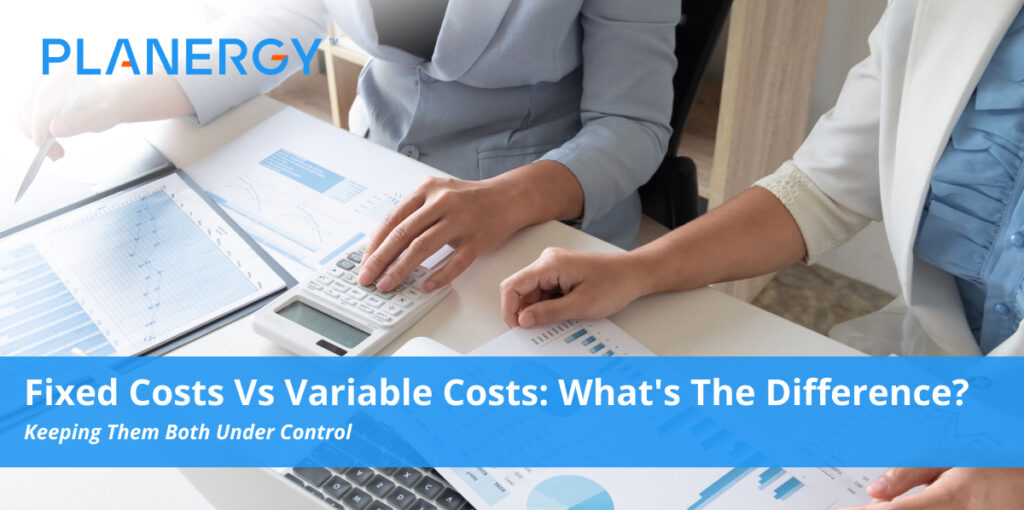If you want to increase your profit, you have to lower both your fixed and variable costs.
Understanding the difference between these two categories as well as how to tell them apart on your financial statements can make it easier for you.
What are Fixed Costs?
Fixed costs may also be called fixed expenses or overhead. These expenses are the same from month to month. They do not change based on your production volume or sales volume.
These costs are the price of staying in business. Even if your organization isn’t making sales, you must still pay the fixed costs.
Regardless of how many widgets you sell, your widget store still has to pay rent. And no matter how many clients your home-based business brings in, you still have property taxes to pay.
Fixed costs are on both your income statement and balance sheet. They tend to stay the same from one month to the next.
They are nice to have because they are a predictable expense, and you know you’ll need at least that much money to stay in business.
However, that predictability comes with side effects. Because they are fixed, it can be hard to change them.
Costs like rent and insurance won’t be easy to change, if at all possible – and cost increases are likely to occur over a period of time.
Fixed Cost Examples for ECommerce
- Subscription fees to ecommerce platforms such as Shopify
- Web hosting fees if not using a platform where that’s included
- Rent
- Utilities
- Internet access
Fixed Cost Examples for Manufacturing
- Equipment maintenance
- Financing payments or depreciation on equipment
- Indirect labor
- Business licenses
- Insurance premiums
Fixed Cost Examples for Events
- Audio and visual services
- Photographer fees
- Legal and consultant fees
- Location rental
- Speaker and performer fees
- Social Media
- Lighting
- Setup crew
- Stage planning
- Invitations
Fixed Costs for Restaurants
- Loan payments
- Permits (health and zoning)
- Rent
- Financing payments or depreciation on kitchen equipment, furniture, etc.
- Insurance premiums
- Point of sale system
What are Variable Costs?
Variable costs, or variable expenses, are those that change from one period to another.
These are under the category of cost of goods sold (COGS). Your total variable cost is the amount of money you spend to produce and sell your products or services.
This includes your labor costs (direct labor) and raw materials (direct materials).
As sales volume and production volume increase, your variable costs increase, too. These costs are also attached to revenue since the more you sell, the more revenue you earn.
If you sell cloth bags, for instance, and because of the holidays, your sales revenue doubles – you’ll see that your variable costs, including the cost of the wholesale cloth bags, also increases.
What you’ll do to lower your variable cost per unit and work to increase your profit margin varies depending on the kind of small business you’re running.
For example, if you’re running a mug business, you could reduce your variable business expenses by training your employees to increase production levels so they’re painting more mugs per hour.
Or, you could find a more affordable wholesaler for your blank mugs. Or, you could use a less expensive paint.
Doing all three of these things could make a big impact on your profit and cash flow.
That said, you need to be able to reduce to the cost of producing your products or services, without sacrificing quality.
The quality level has to be the same as it was before – and if there are mistakes in the painted words on the mugs, like a missing apostrophe, because your staff is rushed, or some of the paint comes off after the customers run the mugs through the dishwasher, you’ll end up with unhappy customers and start to lose business.
If you’re happy with the quality of materials and don’t want to risk a new vendor, you could always form a group buying organization with other businesses to save money or seek to buy it bulk to lower your overall cost per unit.
If you find that you have to cut costs, you should go to your variable expenses first. The lower your total variable cost is, the less it costs you to produce your products or services, allowing you to keep more of your revenue as income.
Examples of Variable Costs for ECommerce
- Raw materials (for handmade items)
- Social media advertising
- Payments to suppliers
- Shipping and handling costs
- Contractors for marketing, social media, and graphic design
- Affiliate marketing or influencer marketing
Variable Cost Examples for Manufacturing
- Direct labor costs
- Raw materials
- Outgoing freight costs
- Credit card and payment processing fees
Variable Cost Examples for Events
- Accommodations
- Refreshments
- Travel fees
- Gratuity fees
- Swag and printable material for guests
Variable Costs for Restaurants
- Marketing
- Breakage
- Food and Beverage Supplies
What are Semi-Variable Costs?
Semi-variable costs are those that cost you a minimum amount every month. Anything higher than that minimum amount is based on how much revenue you earn.
For instance, if you have employees who earn a sales commission, this is a semi-variable cost. Let’s say you operate a car dealership, where you pay your salesmen a base salary, regardless of how many vehicles they sell. That’s the fixed part of your cost.
Then, as a sales incentive, you offer a certain amount of commission on each vehicle they sell for the month. The commission is the variable part – and the more you sell, the more you pay.
Some services may also be semi-variable, depending on the amount of work and time you require.
Web designers, for example, may charge a monthly minimum rate to maintain your website, with an hourly fee above that minimum for any additional work that must be done.
The more business you do, the more your web designer may have to work for you.
Semi-Variable Cost Examples for ECommerce
- Order fulfillment services: You’ll pay a base cost, and a cost associated with the amount and type of inventory managed.
- Pay-per-click advertising: You may have to pay a base fee, plus additional costs when anyone clicks an ad.
Semi-Variable Examples for Manufacturing
- Utilities: There is a minimum cost to keep power and water in your building, but the more you manufacture, the more these things will increase.
- Legal consultations: There will always be a retainer and an hourly fee for any additional work
- Bookkeeping and accounting
Semi-Variable Cost Examples for Events
- Service staff: You will likely have to pay a minimum amount, and as the attendee count increases, be charged more based on that number.
- Insurance and event licenses: Same as above.
Semi-Variable Costs for Restaurants
- Bookkeeping and accounting
- Hourly labor: These costs will fluctuate as you increase or decrease staff hours to match slow and busy times of year.
- Water and electricity: Use will increase based on how busy the restaurant is, but it must remain on to keep the restaurant operational.
Fixed Costs Vs Variable Costs: Which is Better?
Since the two costs are opposites, at first glance, it would appear that one cost is better than the other to have.
Considering that variable costs eat into your revenue – it seems like fixed costs are the better option.
But, when you consider that fixed costs are harder to reduce overall, variable costs seem like a better option.
The reality is that neither fixed nor variable costs are better. When you operate your own company – you’ll have both fixed and variable costs and you’ll need to cover them both. The amount of each and the ratio of each will vary widely based on industry and the nature of your business.
For some businesses, your overhead may account for the majority of your monthly expenses. For others, the variable costs may account for the majority of monthly expenses. You will have both kinds, and one is no better than the other.
To keep a strong business with a good profit margin, aim to decrease all costs. When your costs are lower, direct labor and raw material costs allow you to grow your income. It is more effective to attempt to reduce all corsets rather than obsessing over variable or fixed costs.




